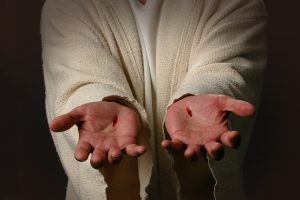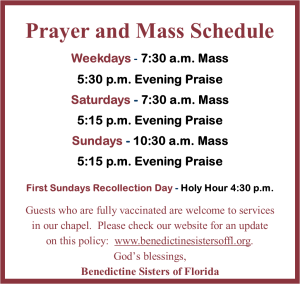 On this third Sunday of Easter, we continue to hear accounts of Jesus’ appearances following his Resurrection. The first lines of this Gospel refer to the Emmaus story. Two disciples were taking a Sunday stroll – well, a seven-mile walk – chatting about the events of the last several days. Suddenly a stranger unceremoniously slipped into their company. In today’s account, the two disciples hurry back to Jerusalem to report the glad news of how they recognized Jesus in the breaking of bread. To their surprise, they discovered that the apostles, still hiding in the Upper Room, were already convinced of the resurrection of Jesus. Mary of Magdala had told them and Simon also had seen Him.
On this third Sunday of Easter, we continue to hear accounts of Jesus’ appearances following his Resurrection. The first lines of this Gospel refer to the Emmaus story. Two disciples were taking a Sunday stroll – well, a seven-mile walk – chatting about the events of the last several days. Suddenly a stranger unceremoniously slipped into their company. In today’s account, the two disciples hurry back to Jerusalem to report the glad news of how they recognized Jesus in the breaking of bread. To their surprise, they discovered that the apostles, still hiding in the Upper Room, were already convinced of the resurrection of Jesus. Mary of Magdala had told them and Simon also had seen Him.
Consistent with all the reports of Jesus’ post-Resurrection appearances, He greets the assembled disciples with the words, “Peace be with you.” They have witnessed the death of someone they loved, and they fear for their own lives. Peace is what they need more than anything else. But, at Jesus’ sudden appearance they are startled and terrified. They are uncertain about what to make of the figure before them. Quite understandably, they mistake Jesus for a ghost. Yet the figure before them is not a ghost; Jesus invites them to experience his resurrected body with their senses, to look and to touch. They can’t forget his sufferings but peace begins to take root in their hearts, as their fears turn to joy and amazement.
This is Jesus: real and alive as he had been over the past three years. He asks for something to eat – a sign they recognize and cannot deny. It convinces them that they are not dreaming or having a mere vision or hallucination. He goes on to explain to them how the prophecies are being fulfilled in him. The evangelist says Jesus “opened their minds to understand the Scriptures.” A lectio experience – one we ask for as we enter into a period of lectio or centering prayer or active contemplation. Sounds like a contradiction: active contemplation? But often it takes concerted effort to “quiet down” to let the Spirit come into our presence. We actively say NO to all the distractions that may tempt us to do almost anything: read, do an act of charity, visit the sick, talk to the lonely, do a puzzle, clean a room, catch up on the news, – the devil calls us to do anything rather than center ourselves to give Jesus prime space and allow the Spirit to “open our minds, our ears, our hearts.” As one author puts it: “contemplation is the gift given simply because we showed up.” Like the disciples, we gather in mutual support. We pray, we eat and Jesus steps into our midst saying: “Peace! See, it is I.”
This gospel, and all the appearances of the resurrected Jesus, show us not only how Jesus convinced his disciples of his resurrection, but this same Jesus prepares us to come together to listen to God’s words and offer ourselves along with our gifts of bread and wine. And don’t minimize the parting message at Mass: “Go forth to share the message you have received.” We can’t share what we do not have – so listen up, attune your mind and your heart, read the Scriptures ahead of time, let the message begin to steep like tea in the warmness of your heart.
The philosopher Soren Kierkegaard once told a story about a circus that caught fire. The flames spread to the fields surrounding the circus grounds and began to burn toward the village below. The circus master, convinced that the village would be destroyed and the people killed unless they were warned, asked if there was anybody who could go to the village and warn the people. The clown, dressed in full costume, jumped on a bicycle and sped down the hill to the village below. “Run for your lives! Run for your lives! “A fire is coming and the village is going to burn!” he shouted as he rode up and down the streets. Curious, the villagers came out of their houses and shops and stood along the sidewalks. They shouted back to the clown, laughing and applauding his performance. The more desperately the clown shouted, the more the villagers cheered. The village burned to the ground and the loss of life was great because no one took the clown seriously. After all, he was just a clown.
When Jesus comes in our door, do we recognize Him? Maybe he’s not dressed as a clown or shouting and waving. How will we recognize Him? Have we met Him often enough in our everyday lives that we immediately recognize Him? Have we met Him in the wounds of the poor? Or in the broken hearts of the bereaved? In the victims of violence? In people who live in dire poverty – maybe with ragged, smelly clothing because they have no place to wash up? Maybe there are times when it is easier to see Jesus in the face of the stranger or the guest than it is in the face of the Sister (spouse, person) across from us at the dinner table or the chapel aisle or walking the hallways. Jesus says: “Look at my hands and my feet (we can add: look at my face); see that it is I, your Lord.”








